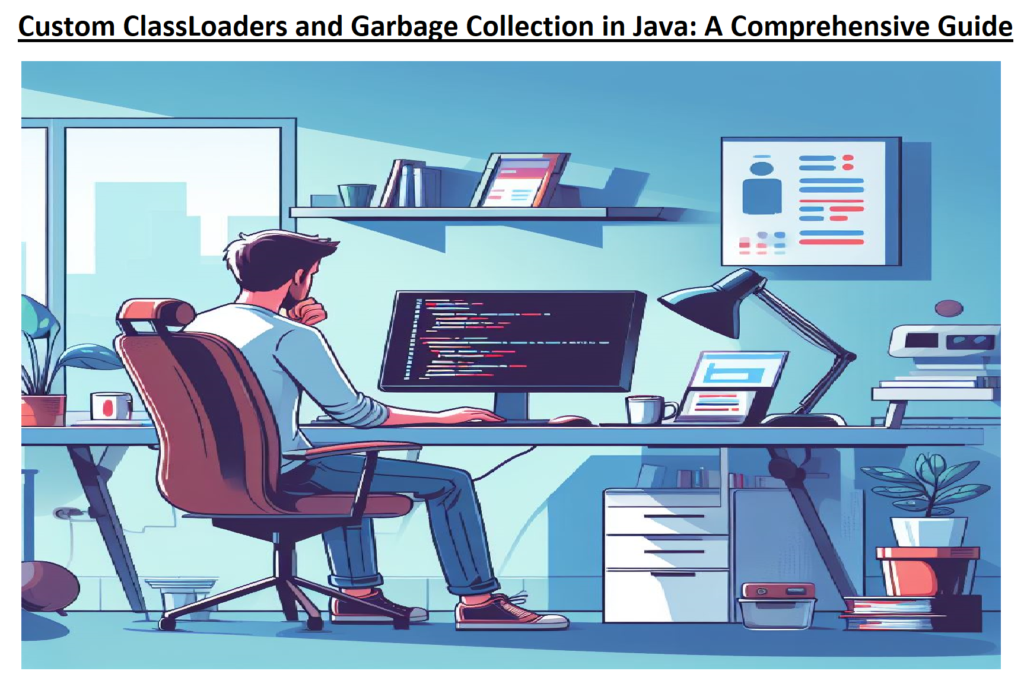Java’s ClassLoader plays a crucial role in loading classes into the Java Virtual Machine (JVM). In this guide, we explore the relationship between custom ClassLoaders and garbage collection, providing code examples and addressing frequently asked questions.

Table of Contents
1. Introduction
Understanding ClassLoaders in Java
Java uses a hierarchical class loading mechanism. Each ClassLoader, except the bootstrap class loader, has a parent ClassLoader. When an object is loaded by a ClassLoader, it retains a reference to that ClassLoader. This relationship is crucial for understanding how objects become eligible for garbage collection.
Relationship with Garbage Collection
Objects loaded by a ClassLoader can only be garbage collected when the ClassLoader itself becomes unreachable. This is a key consideration when dealing with custom ClassLoaders, as they may have implications on memory management.
2. Custom ClassLoader with Unloading
Dynamic Class Loading
A custom ClassLoader allows for dynamic loading of classes at runtime. This can be particularly useful in scenarios where classes need to be loaded on-demand, providing flexibility in the application’s design.
Class Unloading
Java typically does not unload classes until the ClassLoader is garbage collected. However, a custom ClassLoader provides the opportunity to explicitly unload classes, allowing for dynamic memory management.
Code Example and Explanation
import java.io.IOException;
import java.nio.file.Files;
import java.nio.file.Path;
import java.nio.file.Paths;
public class CustomClassLoaderExample {
public static void main(String[] args) throws ClassNotFoundException {
CustomClassLoader classLoader = new CustomClassLoader();
try {
// Load class dynamically
Class<?> loadedClass = classLoader.loadClass("MyClass");
// Create an instance of the loaded class
Object instance = loadedClass.getDeclaredConstructor().newInstance();
// Use the instance
if (instance instanceof MyInterface) {
((MyInterface) instance).doSomething();
}
// Unload the class
classLoader.unloadClass("MyClass");
} catch (Exception e) {
e.printStackTrace();
}
}
}
interface MyInterface {
void doSomething();
}
class MyClass implements MyInterface {
@Override
public void doSomething() {
System.out.println("MyClass is doing something.");
}
}
class CustomClassLoader extends ClassLoader {
private static final Path CLASS_PATH = Paths.get("path/to/classes/");
public Class<?> loadClass(String name) throws ClassNotFoundException {
// Check if the class has already been loaded
Class<?> loadedClass = findLoadedClass(name);
if (loadedClass != null) {
return loadedClass;
}
// If not, load the class from the file system
try {
byte[] classData = Files.readAllBytes(CLASS_PATH.resolve(name + ".class"));
return defineClass(name, classData, 0, classData.length);
} catch (IOException e) {
throw new ClassNotFoundException("Class not found: " + name, e);
}
}
public void unloadClass(String name) throws ClassNotFoundException {
try {
// Unload the class by removing it from the loaded classes
super.loadClass(name, true);
System.out.println("Class unloaded: " + name);
} catch (ClassNotFoundException e) {
throw new ClassNotFoundException("Class not found: " + name, e);
}
}
}
Explanation:
- The
CustomClassLoaderclass extendsClassLoaderand loads classes from a specified directory (CLASS_PATH). - The
CustomClassLoaderExampledemonstrates dynamic loading of the classMyClass, creating an instance, and using it. Afterward, it unloads the class using the customunloadClassmethod.
3. WeakReference for Class Loading
Leveraging WeakReference
WeakReference is a class in Java that allows objects to be garbage collected when there are no strong references to them. This can be particularly useful when managing loaded classes through custom ClassLoaders.
Garbage Collection Considerations
Using WeakReference in the context of class loading allows for more flexible memory management. If there are no strong references to a loaded class, it can be collected by the garbage collector.
Code Example and Explanation
import java.lang.ref.WeakReference;
public class WeakReferenceExample {
public static void main(String[] args) {
CustomClassLoader classLoader = new CustomClassLoader();
WeakReference<Class<?>> weakRef = new WeakReference<>(classLoader.loadClass("MyClass"));
// Use the loaded class through the weak reference
Class<?> loadedClass = weakRef.get();
if (loadedClass != null) {
System.out.println("Class found: " + loadedClass.getName());
} else {
System.out.println("Class has been garbage collected.");
}
}
}
class CustomClassLoader extends ClassLoader {
public Class<?> loadClass(String name) {
// Implement class loading logic here
// ...
// For simplicity, let's assume a class named MyClass is loaded
return MyClass.class;
}
}
class MyClass {
static {
System.out.println("MyClass initialized.");
}
}
Explanation:
- The
WeakReferenceExampledemonstrates using aWeakReferenceto reference a loaded class (MyClass) through theCustomClassLoader. - The example shows that if there are no strong references to the loaded class, it may be garbage collected.
4. Best Practices and Considerations
When to Use Custom ClassLoaders
Custom ClassLoaders are powerful but come with complexity. Use them when dynamic class loading or unloading is necessary, such as in frameworks that support plugins or hot-swapping of classes.
Potential Pitfalls
Managing your own ClassLoaders can introduce subtle bugs. It’s crucial to understand the implications and thoroughly test custom ClassLoader implementations. Avoid unnecessary complexity unless your use case specifically requires it.
Balancing Flexibility and Complexity
Balance is key. Only introduce custom ClassLoaders when the benefits outweigh the complexities they bring. Standard class loading mechanisms provided by the JVM are often sufficient for most applications.
5. FAQs (Frequently Asked Questions)
Q1: Why would I need a custom ClassLoader?
A1: Custom ClassLoaders are useful in scenarios requiring dynamic class loading or unloading, such as in frameworks that support plugins or hot-swapping of classes.
Q2: How does class unloading impact memory management?
A2: Class unloading allows for the dynamic release of memory occupied by classes that are no longer needed. This can be advantageous in situations with memory constraints.
Q3: What is the role of WeakReference in garbage collection?
A3: WeakReference allows objects to be garbage collected when there are no strong references to them. It provides a way to manage memory more flexibly, especially in scenarios involving custom ClassLoaders.
Q4: Are there potential risks or drawbacks in using custom ClassLoaders?
A4: Yes, custom ClassLoaders can introduce complexity and potential issues, such as classloading leaks or conflicts. Thorough testing and understanding of the Java ClassLoader hierarchy are essential to mitigate these risks.





